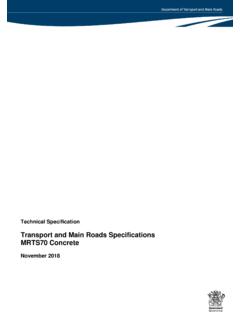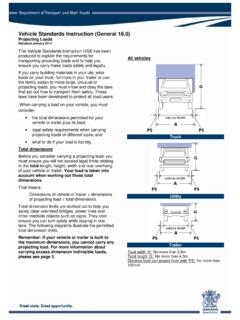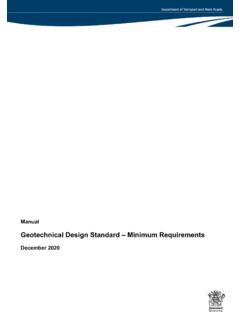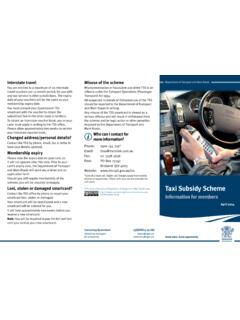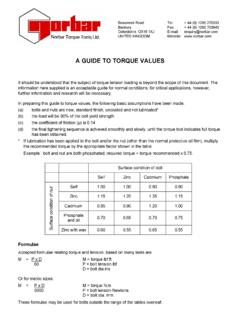Transcription of Assembly and Tensioning of High Strength Bolts and Nuts ...
1 Technical Note 62 Assembly and Tensioning of High Strength Bolts and Nuts - Part 1: Class November 2015 Technical Note, Transport and Main Roads, November 2015 Copyright State of Queensland (Department of Transport and Main Roads) 2015 Feedback: Please send your feedback regarding this document to: TN62 Assembly and Tensioning of High Strength Bolts and Nuts - Part 1: Class 1 Clarification of bolt Tensioning The purpose of this technical note is to define the acceptable requirements for the Assembly and Tensioning of High Strength Bolts for Department of Transport and Main Roads (TMR) projects. 2 Reference documents A number of reference documents have been used to compile this technical note. The reference documents are outlined below. Transport and Main Roads Technical Specification MRTS78 Fabrication of Structural Steelwork Australian Standard AS 4100 1998 Australian Standard AS 1252 1996.
2 3 Identification of conforming materials All Bolts and nuts shall be from tested batches. All Bolts and nuts shall be tested in accordance with MRTS78 Fabrication of Structural Steelwork. The contractor shall only use Bolts , nuts and washers complying with AS 1252. These Bolts , nuts and washers have identification marks embossed on the top of the bolt head, the top surface of the nut and protrusions on the edges of the washers. Figure 3 shows the markings for the bolt, nut and washer. Figure 3 Markings for structural assemblies Inspection by the contractor of Bolts , nuts and washers for damage to the threads and the galvanising shall take place before fitting. The contractor shall discard any damaged Bolts , nuts and washers. 4 Tensioning of Bolts There are three bolting categories defined in AS 4100-1998.
3 The Bolts are installed and tensioned to snug tight . AS 4100 defines snug tight as, "The tightness attained by a few impacts of an impact wrench or by the full effort of a person using a standard podger spanner , which brings the connecting parts into firm contact. Technical Note, Transport and Main Roads, November 2015 1 TN62 Assembly and Tensioning of High Strength Bolts and Nuts - Part 1: Class and (or when referring to both types) The Bolts are installed and are fully tensioned in a controlled manner. There are four methods of Tensioning the Bolts : 1. The use of an adjustable and correctly calibrated impact wrench. The equipment required is a load cell (similar to the Skidmore Willhelm Gauge) and an adjustable impact wrench. This equipment is unavailable.
4 Therefore, the contractor will be unable to use this method. 2. The use of the part turn method. Please note this method is not permitted as, there is a variation in bolt tension using this approach. 3. The use of load indicator washers. This method would be acceptable, for when the bolt head and load indicator washer can be clearly seen. 4. There is another method not in the Code. Some Bolts /rivets requiring replacement have their heads inside chord members. This would make checking the gap between the load indicating washer and the underside of the head difficult. By using an adjustable impact wrench, calibration of the system could occur by assembling a series of Bolts , nuts and load indicating washers in a simple joint in the workshop. Calibration of the wrench would be by using load indicator washers to determine the appropriate wrench setting for field usage.
5 5 Non acceptable method of Tensioning Bolts The reason the part turn method is not acceptable is outlined below. A typical structural bolt, for example a M24 bolt will typically require a torque of approximately 800 Nm in order to fully tension the bolt. A torque of 800 Nm is equivalent to applying a force of 81kg over a 1000 mm long spanner. The normal podge spanner is roughly 500 mm long, so assuming that the force could only be applied at about 400 mm, you would need to apply a force of 204kg at this distance. In the past workers would place extensions on standard spanners in order to tension Bolts , refer to Figure 5. This process is both risky from a safety perspective and does not ensure a consistent tension force is applied to all the Bolts . It is not practical to apply forces of this magnitude to a spanner particularly when working at heights.
6 Hence why manual Tensioning of Bolts is not permitted. Figure 5 Extension placed on the end of a ring spanner Technical Note, Transport and Main Roads, November 2015 2 TN62 Assembly and Tensioning of High Strength Bolts and Nuts - Part 1: Class 6 Acceptable method for Tensioning Bolts The accepted method for fully Tensioning T/F and T/B Bolts is as follows. Load indicating washers When the bolt head and nut are clearly visible at a bolted connection, the load indicating washers shall be used. There are two types of load indicating washers. Conventional load indicating washer - The first type of load indicating washer is the conventional load indicating washer as outlined in AS/NZS 1252. After Tensioning , the average gap needs to be measured with a feeler gauge. For galvanised Bolts , the minimum gap required between the head and the load indicating washer is mm.
7 Squirter DTI load indicating washers - The second type of load indicating washer is the Squirter DTI supplied by Hobson Engineering. As the bolt is tensioned, a calibrated amount of orange silicone appears from under the DTI s squirt locations. If the Squirter DTI load indicating washers are used. The bolting arrangement will need to be calibrated for each batch of load indicating washers supplied for the project. Squirter DTI calibration of load indicating washers In a Skidmore Insert a bolt, Squirter DTI, washer and nut into the Skidmore. Tighten the Assembly to about 10% to 20% over the minimum required tension as outlined in AS 4100, in the same manner to be used to tension the bolt Assembly . Once tightened, note the appearance of the flow volume and the number of squirts emanating from under the DTI.
8 If the DTI has five bumps there should be at least four squirts from the DTI. The calibration process will need to be repeated a total of three times to obtain a visual impression of how much squirt is necessary. In Solid Steel Insert a bolt, Squirter DTI, washer and nut into a steel section. Tighten the bolt Assembly until the DTI has sufficiently compressed so that a feeler gauge of the correct thickness ( mm ( ") if the DTI is on the nut end, or mm ( ") if the DTI is under the head) will not enter half of the available places right into the bolt shank. If it does, tighten the bolt a little more and note the silicone squirt volume and appearance. The calibration process will need to be repeated a total of four times to obtain a visual impression of how much squirt is necessary.
9 Note: For installation of Squirter DTI s in old or reconditioned steelwork, it may be necessary to place hardened flat washer against the steel surface and under the Squirter DTI s so that the squirter feature works reliably. 7 Acceptable method for Tensioning Bolts The accepted method for fully Tensioning T/F and T/B Bolts is as follows. For the Tensioning of the Class Bolts , only a calibrated torque wrench can be used. Technical Note, Transport and Main Roads, November 2015 3 TN62 Assembly and Tensioning of High Strength Bolts and Nuts - Part 1: Class Types of Tensioning equipment Figure (a) Electric torque wrench Accuracy of +/- 4% Figure (b) Hydraulic torque wrench Technical Note, Transport and Main Roads, November 2015 4 TN62 Assembly and Tensioning of High Strength Bolts and Nuts - Part 1: Class Figure (c) Pneumatic torque wrench Technical Note, Transport and Main Roads, November 2015 5 TN62 Assembly and Tensioning of High Strength Bolts and Nuts - Part 1: Class Calibrated impact wrench This process is only permitted when the Bolts already in stock are too short to accommodate the washer, nut and load indicating washer.
10 In order to ensure that the tension wrench is correctly calibrated, there are two options available. Option 1 1. Place a bolt Assembly in a Skidmore Willhelm Gauge with a Squirter DTI load indicating washer Refer to Figure (a) 2. Tension the bolt with a tension wrench to the required tension as outlined in AS 4100 and Table 3. Note the torque setting on the tension wrench to achieve the required tension force. Please note that the torque setting is based on the constant application of force in a single movement 4. Once the torque wrench has been set for the specific bolt and nut, the torque wrench is placed on a Norbar True Checker, refer to Figure (d). The True Checker will confirm the torque setting for that specific bolt and nut combination. Figure (a) View of a skidmore Table Minimum bolt tension Nominal diameter of bolt Minimum Bolt Tension kN Max Upper Limit Bolt Tension kN M16 95 115 M20 145 185 M22 180 (Note 1) 230 (Note 1) M24 210 265 M30 335 420 M36 490 610 Note 1: M22 tension capacity based on linear interpolation Technical Note, Transport and Main Roads, November 2015 6 TN62 Assembly and Tensioning of High Strength Bolts and Nuts - Part 1: Class Option 2 Place a bolt, nut and washer Assembly along with a Squirter DTI load indicating washer in a solid steel section Refer to Figure (b).



